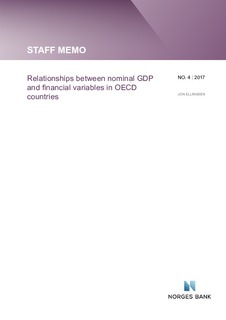| dc.contributor.author | Ellingsen, Jon | |
| dc.date.accessioned | 2018-07-24T13:46:18Z | |
| dc.date.available | 2018-07-24T13:46:18Z | |
| dc.date.issued | 2017 | |
| dc.identifier.isbn | 978-82-7553-974-6 | |
| dc.identifier.issn | 1504-2596 | |
| dc.identifier.uri | http://hdl.handle.net/11250/2506378 | |
| dc.description.abstract | I look at the short-term relationship between nominal GDP and credit and nominal GDP and house prices in 20 OECD countries. In the recent years central banks have become increasingly concerned with financial stability. These concerns sometimes lead to trade-offs for monetary policy. One important policy question is how the variables related to financial stability is related to different macroeconomic aggregates followed by the central bank. I find considerable similarities in the short-term relationship between the variables across the countries in the data set. The cross correlations are notably large, and there are relatively stable lead/lag structures across most countries. I also develop a synchronization indicator which shows that the variables tend to follow the same growth cycles. | nb_NO |
| dc.language.iso | eng | nb_NO |
| dc.publisher | Norges Bank | nb_NO |
| dc.relation.ispartofseries | Staff Memo;4/2017 | |
| dc.rights | Attribution-NonCommercial-NoDerivatives 4.0 Internasjonal | * |
| dc.rights.uri | http://creativecommons.org/licenses/by-nc-nd/4.0/deed.no | * |
| dc.title | Relationships Between Nominal GDP and Financial Variables in OECD Countries | nb_NO |
| dc.type | Working paper | nb_NO |
| dc.subject.nsi | VDP::Samfunnsvitenskap: 200::Økonomi: 210 | nb_NO |
| dc.source.pagenumber | 24 | nb_NO |

